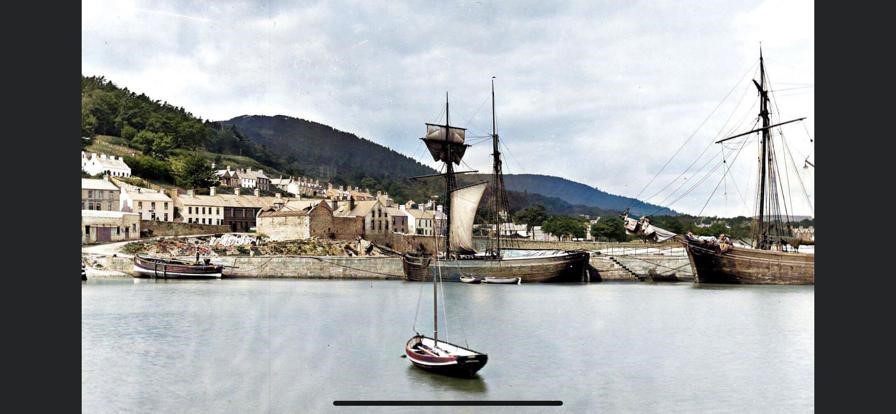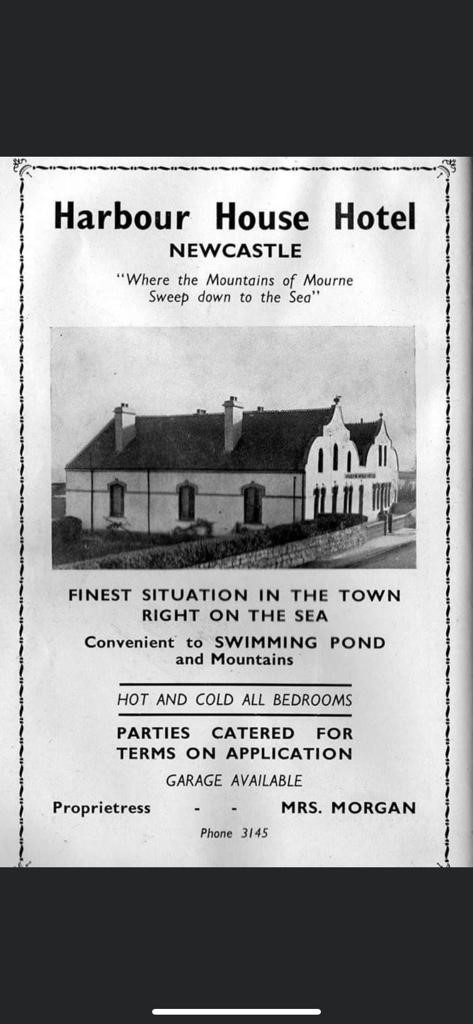Harbour History
This Hotel (The harbour house Inn) is a 19th century building built around 1907, but the history of the harbour area itself and its families go way back further than that with many generations being made up of mainly fishermen, the area itself for how old and established it is has a relatively small population compared to the town itself many due to its steep mountain location, the harbour end of town has always been known for its fishing hence why the harbour walls have been repaired so many times over the centuries, after many huge storms that damaged the south pier over and over again it was repaired time after time to protect the many small fishing boats including (skiffs ) and the larger boats such as (schooners) that were often used for exporting Granite from the quarries high up in the mountains of Mourne (see Granite Trail and mountain walks below).
The fishing in this area was the main source of most people’s income and they heavily relied on the fishing to pay the rent and keep their families from starvation and some making a few shillings along the way by supplying fish to the many restaurants and cafes that served the many tourists who were flocking to the many guest houses and hotels at that time, some locals even supplying The Harbour House Inn itself with their supply of fresh fish
There have been many fishermen lost to the sea in Dundrum bay over the centuries but on one particular occasion on 13 January 1843, many boats from Newcastle and Annalong set out from their harbours towards their favourite fishing spots only to be caught by surprise in a sudden storm of high winds hale sleet and snow, in total around 14 boats were lost most of them from Newcastle, the heavy seas sank nearly all the boats including a boat which had gone out to help rescue the fishermen in turn drowning all 12 of the crew. Only two boats survived and they are believed to be The Victoria and The Brothers, in total it is believed that 72 men perished on that terrible day, 46 of whom were from Newcastle and 26 from Annalong the lost fishermen left behind them twenty seven widows, fourteen heads of families and about seventy four children.
Not long after the disaster money was raised locally to help the worst hit widows and their children by the building of a row of cottages commonly known by locals as The Widows Row and they still stand to this day, they are easy to find when you leave through the doors of the hotel turn left and walk past the harbour then cross over when you reach the huge old coastguard house/station as you walk up the road on south promenade you will see the row of cottages on the right overlooking Dundrum Bay.
For many years the coastal waters of Dundrum bay were protected by a lifeboat station in the town stationed on the shore off the Downs Road but that all changed 1930 when the lifeboat was permanently moved to the harbour end of town and since that day the brave crews of the RNLI over generations have saved many lives over the years.
GRANITE TRAIL and mountain walks
In 1824 John Lynn opened a Quarry on Millstone Mountain and laid a mineral railway line to King Street. By 1859 the railway was diverted to the then more productive quarry on Thomas’s Mountain. The Granite Trail follows the route where the track once stood, known locally as the ‘Bogie Line’ hence the name of Bogie hill on king street just opposite this hotel, the Granite Trail was at its busiest in the late 1800s, tens of thousands of tonnes of granite were produced here every year. By the end of the Second World War, however, the line had fallen into disuse and was dismantled. Much of the granite mined from this quarry can still be seen today in many cities in England in particular; Liverpool with its huge granite buildings and large curb stones near the docks, the granite was often swapped for minerals that Ireland had little of, such as welsh slate hence why there are so many houses in this area with slate roofs
Harbour House Today
We have a great return trade now offering 8 bedrooms all en-suite with extras as standard. We offer 4 rooms with panoramic views of Dundrum Bay.
The food on offer is of a high standard using local butchers, local vegetable allotments, local fishmongers and even our till rolls are bought from local merchants.
The food has imagination and creativity and changes as the seasons do. We like to keep the ol’ regulars on the menu as they are so fondly liked by locals and customers who visit us.
We offer discounted meals and deals with local charity cinemas, theatres, outdoor pursuit centre’s taxis firms and seaweed baths. We believe in returning custom to those that bring it to us.
The seaside setting offers an unbelievable backdrop that you could gaze at all day. We hold tea and coffee for the local swimmers on various occasions and we always have hot water bottles and blankets on the ready for anyone wishing to have a dip in the Irish Sea.
Walks
The Granite Trail to Thomas’s Quarry is just over 1,100 metres long but because of the steep rise, you should allow approximately one and a half hours to complete this stage.
An optional return route from the Quarry of approximately 4 kilometres via Donard Wood and Glen River Track to the north of the Quarry is available and will take between two to three hours.
Along the route of the trail, there are stunning views over Dundrum bay and its harbour. Additionally, there are artefacts relating to the quarrying of granite on the mournes such as ‘slipes’, ‘bogies’ and ‘shoddy huts’, as well as information panels explaining more about the route.
A viewpoint just in front of Thomas’s Quarry offers spectacular views of Newcastle and Dundrum Bay. On a clear day, walkers will have the opportunity to see as far as the Isle of Man, Scrabo Tower, St John’s Lighthouse, Slieve Croob and the town of Castlewellan.
I am often asked which are the easiest paths on the mountain to use and the simple answer to that is there are not many easy paths when you are ascending a mountain but if I was pushed to answer I would walk south along the king street until you reach a row of houses above you on the right called Delarey Terrace with steep steps leading the their front doors, continue to walk past them for a nice easy stroll just walk straight ahead along the mountain path southwards or alternately turn right directly after the row of houses and you will find many path’s zigzagging up down and across leaving the decision to you which route to take, there are marker posts showing in colours how hard or easy each path is, good luck and enjoy.
In the past 5 years, the business has been run by the next generation, Frank & Brenda’s son and daughter, Darragh Connolly and Frances Monteith. We are now at the start of our journey and hope we can deliver first class accommodation and meet the needs of our diverse customer base.





Shhh… Get the latest deals and discounts straight to your inbox.
